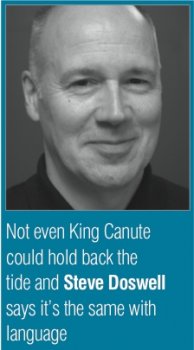
STEVE DOSWELL FIGHTS FOR CORRECT LANGUAGE USAGE
“It’s interesting how language usage changes and sometimes puzzling when it does”
 It’s interesting how language usage changes and sometimes puzzling when it does. It took me a while to understand why a new app was ‘fully native.’ But you can’t stop the music – or the language. There are rules for usage but no single force that will stop it changing daily via 101 subtle shifts of meaning. Like the sea, it ebbs and flows and no amount of human diktat – royal or otherwise – is going to alter that.
It’s interesting how language usage changes and sometimes puzzling when it does. It took me a while to understand why a new app was ‘fully native.’ But you can’t stop the music – or the language. There are rules for usage but no single force that will stop it changing daily via 101 subtle shifts of meaning. Like the sea, it ebbs and flows and no amount of human diktat – royal or otherwise – is going to alter that.
In the world of work, we’re well-used to changes in the language we hear and speak. Sometimes it’s about adopting a familiar word and attaching a new, unrelated meaning. Other times, it’s about using new words for old concepts. There can be a whiff of old wine in new bottles about this – mindfulness as a 21st century reworking of meditation, for example. But that’s absolutely fine if it’s about repackaging an existing and useful idea for a different age, provided we have our snake oil sensors set to sniff out exaggerated claims that oversell the benefits. In this case, ‘mindfulness’ may bring a potentially helpful practice to the attention of a new and receptive audience that may otherwise shy away from hippy connotations of the word ‘meditation.’
Incidentally, as long ago as the late 1990s, the California-based culture-change consultancy Senn Delaney was introducing UK gas distribution employees to a range of mental coping tools within a programme called ‘You Make The Difference.’ Recalled almost 20 years later, these look a lot like the techniques of mindfulness.
Employee involvement is another durable concept couched in the terminology of the past. It holds out the promise that involving employees as much as possible in planning and decision making will increase their commitment and sense of ownership, leading to higher levels of employee retention and an environment in which people choose to contribute and be motivated, all resulting in improved organisational health and, ultimately, success. Sounds familiar? It does if you tweak the language ever so slightly and swap involvement for engagement. But if ‘employee involvement’ was widely espoused as a way of describing a management philosophy of treating employees as stakeholders as a valuable source of insight, with a legitimate voice and valid opinions to be heard, it never ‘went viral’ or enjoyed the same universal acclaim as its joined-at-the-hip C sibling, employee engagement. But plenty has already been said on that topic, so let’s tune in to another channel.
During the war years of the 1940s, my late grandmother used to listen to the ‘wireless.’ In the 1970s, her grandson discovered so much of MY the music he still enjoys today by listening to the ‘radio.’ Same thing, different words. True, she had to listen on a piece of furniture (the radiogram, now found mainly in museums or on eBay) that seemingly bore no relation K to the transistor frequently hidden under my pillow for late night listening. But it was essentially the same technology. Wind forward to 2016 and life for her great-grandson would be unthinkable without wireless access. Now, though, that familiar word from the early 20th century has come to mean something different. Incidentally, although radio’s demise has been long-predicted, its popularity endures and its audiences are growing. That’s perhaps a surprise, given the allure of many glitzier alternatives for information and entertainment. But if radio as a technology remains in rude health, the production of radio sets has plummeted. Now I’m as likely to be listening to the news at breakfast on my tablet. Try explaining that to my grandmother.
Steve Doswell is chief executive of the Institute of Internal Communication



